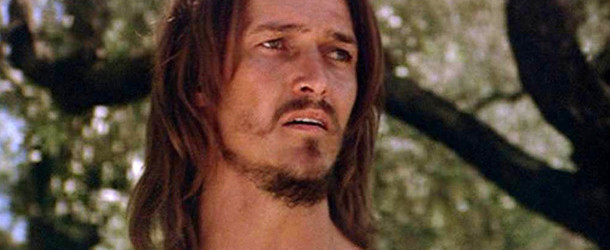It’s pretty rare that a movie leaves me with a raised eyebrow and an invisible “WTF?” bubble above my head.Jesus Christ Superstar, however, did the job.A mini-Jesus singing in a four-octave range while rock climbing?An Asian Mary Magdalene and a black Judas Iscariot?Guards with machine guns?Rock music?An army tank?!Excuse the language when concerning the topic, but what the hell is this?
Let me get this out of the way first: After seeing Andrew Lloyd Webber’s visual mental disorders such as Evita and Phantom of the Opera, and some stupid video of the play Cats, I certainty had warranted low expectations.The three movies are mostly people singing for the entire running time—a blessing for some, a curse for others.And this one bears the same… blurse?I also wasn’t expecting a serious interpretation of the story of Jesus like in Passion of the Christ.All I knew was that this was a rock-opera based on the last days of Jesus of Nazareth.
I’ve read that this musical stirred up some sort of controversy upon release.To those who would be offended by this harmless movie, I say this: Get over it.This movie is about as offensive as a Girl Scout troop.Yes, it’s about Jesus, and yes, it’s mostly from the point-of-view of Judas Iscariot, and yes, it’s set to rock-n-roll with needless military props and people wearing stupid hats.But it certainly isn’t set out to deliver a message.That much is obvious.
We begin in the deserts of Israel, watching a group of what appears to be young college students departing a bus and pulling out some props.I can’t say if the play begins in the same fashion, but it’s an odd way of doing things either way.We soon learn that these are the actual actors about to star in the movie, as they begin to put on makeup, don costumes, and then, as the main musical refrain hits its climax, the actor who plays Jesus (Ted Neely) is revealed.With the shoulder-length sandy-blonde locks, and the bright blue eyes, Neely is about as close to the Roman version of Jesus as it gets, albeit a bit on the short side.
The story of Jesus and his conflict with Judas is told with each scene set to its own song—all leading to the crucifixion. I can safely say that I had to fill in a lot of what was going on with my own outside knowledge of these events.There are a lot of holes to fill in.The story isn’t told cohesively and a few semi-major changes have been made from the source material.If you haven’t read the Bible, or you haven’t been told how Jesus spent his last few days, you won’t be left enlightened with some newfound spiritual understanding.
The story changes didn’t bother me, though.I understand the need for adaptation to the big screen, and they, ultimately, don’t really change anything.Jesus still dies in the way we all know (was that a spoiler alert?).The only thing that happens is Judas’ true point-of-view, depending on how you interpret the Bible, might be a little bit hidden.They make him appear more compassionate than the text reveals.The Bible speaks of ulterior motives to the things he says he wishes for, such as helping the poor.But still, the movie isn’t bashing over a billion people’s Lord and Savior.Even the title of the movie glorifies him, so, again, move on.
What did bother me with this film, however, is the hideous backdrop of the Israeli desert.What was the point of filming at this location?Why did director Norman Jewison make this judgment call? This place is in ruins, which certainly wouldn’t have been the case over 2000 years ago.A sound stage would have been just as simple.Even remote parts of Arizona would have worked, since unsightly wasteland is apparently what they were going for.The background just doesn’t do anything for the movie, and I’m one of those reviewers who firmly believes that the backdrop always plays a supporting character.This made me feel like I was watching a dress rehearsal, or perhaps an unfinished product.And the thing with the bus at the beginning does set the tone for the movie to appear to be made on a shoestring budget.It even took me a couple seconds to realize a picnic scene was apparently The Last Supper.It’s that cheap.
After reading all these drawbacks, you might wonder why I’d be recommending this movie.Well, quite honestly, I’m recommending it because it’s one of the few movies that left me with the curious eyebrow and “WTF” bubble.I don’t get it, I don’t get the point of it, but that doesn’t mean it’s not interesting.I’d watch it again.And, despite the sad fact the movie is all in song, the staging is solid, and the songs are… well, pretty great.This isn’t the dorky music like A. L. Webber’s later work.
There are the standouts songs such as the main titular overture, “I Don’t Know How to Love Him,” “Everything’s Alright,” and “Gethsemane.”The rest is passible filler with few leitmotifs, but it’s all sung incredibly well.Ted Neely’s voice is mind numbing, in a good way.He can float high notes better than any heavy metal singer around, and he does so without breaking into falsetto, which is equally amazing.He nails difficult scales with ease—and, in a musical, that seems like something Jesus should be able to do.So it fits.Golden-voiced Yvonne Elliman embodies Mary Magdalene with finesse and sympathetic expression.Her facial expressions and vocal inflections are evocative and believable.She’s a true underrated talent.Carl Anderson’s Judas is soulful, which works well against Neely’s more refined timbre.
The movie comes to a close back on the bus.That damned bus.All main cast members enter one by one, as if expecting applause.That is, all but one.Neely is nowhere to be found.I guess Jewison was aiming for poignancy by not showing the resurrection.Read into what you want.In the song, “I Don’t Know How to Love Him,” Mary Magdalene sings the lyrics, “What’s is all about?” a couple of times, and that about sums it up for me.I don’t know how to feel about this movie.But, alas, don’t worry; this is not the same Andrew Lloyd Webber fluff that later polluted Broadway and the West End for decades. All in all, I suppose I’m recommending the soundtrack more than the film itself, but as a package, it is such a psychedelic rush that it’s worth the 108 minutes.








